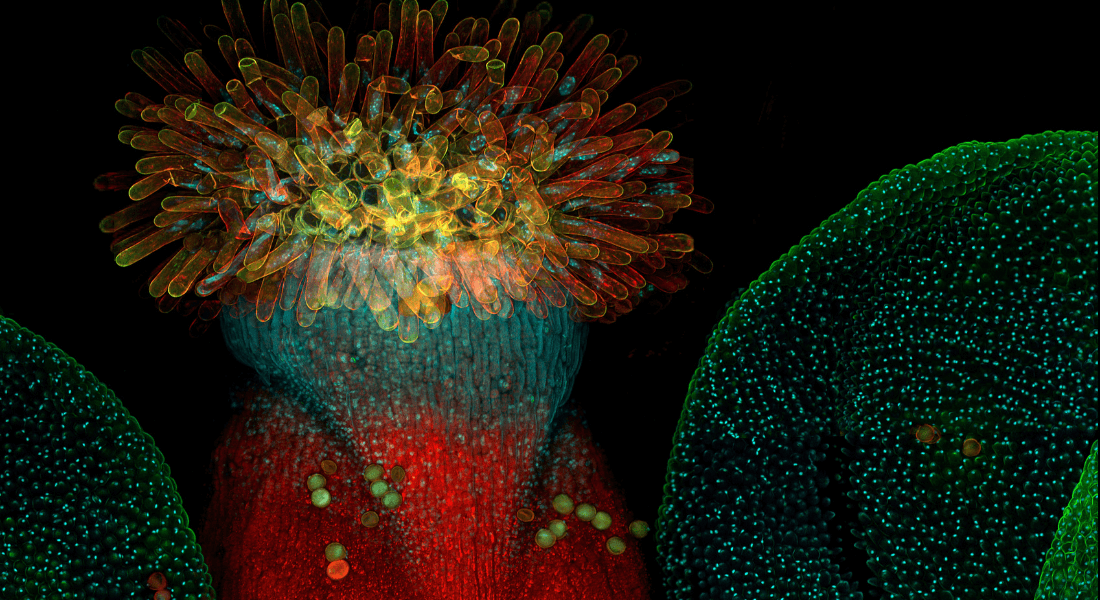PhD defence by Nanna Isabella Østerlund

Investigation of filamentous structures with focus on the actin cytoskeleton and three-dimensional cell and air structures inside leaves
Plant cells contain vacuoles, which is a liquid storage compartment that occupies most of the cell volume. Due to the large vacuole, the cytoplasm, in which the cytoskeleton resides, occupies a slender margin adjacent to the cell wall. The cytoskeleton just beneath the plasma membrane is termed the cortical cytoskeleton, and this part of the cytoskeleton is crucial in various essential processes. For instance, it enables cells to function, expand, and respond to pathogen attacks by making rapid adjustments in cell structure and function. The cortical actin cytoskeleton is a highly dynamic system consisting of filamentous structures that overlap and loop in on themselves to form a complex tree-like network. This intricate system is not yet fully understood, and automated tools are needed to investigate its structure and dynamics.
The spatial arrangement of the cytoskeleton also determines the expansion sites of the cell wall, influencing cell shape and, on a larger scale, the organisation of cellular tissue. The positioning of the cytoskeleton is controlled by an intricate system of associated proteins. Studying the impact of the cytoskeleton on cell morphology can therefore provide new insights into leaf cell architecture.
A systematic in-depth literature review of methods for tracing and tracking of filamentous structures across scales indicated that there is a gap for automated tools that robustly perform pre-processing, tracing, and tracking of highly bent and dynamic dense network systems. I therefore developed an automatic graph-based tool to trace and track filamentous structures, enabling the investigation of highly dynamic bent filamentous structures such as the actin cytoskeleton. This method utilises graph theory, translating image data of filamentous structures to a network, allowing one to perform a constrained depth first search to identify individual filamentous structures. The resulting tool facilitates robust pre-processing, segmentation, and unbiased identification and tracking of the wanted filamentous structures. We demonstrate that the tool outperforms current state-of-the-art methods and investigate the actin cytoskeleton in Arabidopsis thaliana cells in relation to growth and stress conditions. I anticipate that the use of GraFT will help gain knowledge on how the actin cytoskeleton works in plant cells, as well as other filamentous structures. I have furthermore investigated the morphological changes in Arabidopsis thaliana leaves of wildtype as well as two cell shape defective transgenic lines.
| The transgenic lines were disturbed in the Rho of Plant (ROP) and ROP-interactive CRIB- containing proteins (RIC) pathway altering the function of the cytoskeleton. These lines were imaged at different ages using X-ray Phase Contrast micro-tomography to obtain three-dimensional sections of leaves. The high resolution three-dimensional image datasets were processed by developing and deploying a deep learning based segmentation algorithm. The segmented data sets were analysed, revealing that the RIC-ROP pathway influences the shape of the internal leaf cells. The changes in cellular shapes affected the spatial structure of the internal air space of the leaves, which is paramount for the ability of the leaves to perform gas exchange, photosynthesis, and respiration for water movement. Furthermore it was found that the altered air space gave rise to a worsened ability for air to traverse through the leaf. From this we conclude that the RIC-ROP pathway influences the structure of internal air space in leaves. SupervisorsProfessor Staffan Persson, PLENZoran Nikoloski, University of Potsdam Assessment committeePrincipal Investigator Richard Smith, John Innes CentreAssociate Professor Kaare Hartvig Jensen, DTU Associate Professor Bodil Jørgensen, PLEN (Chair) Time and venue11th June at 13:00 CPSC Auditorium |
